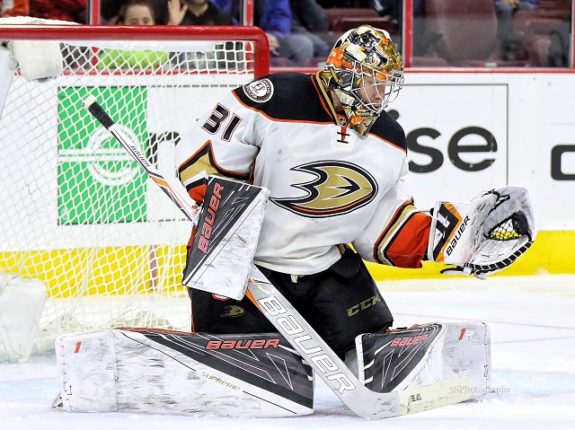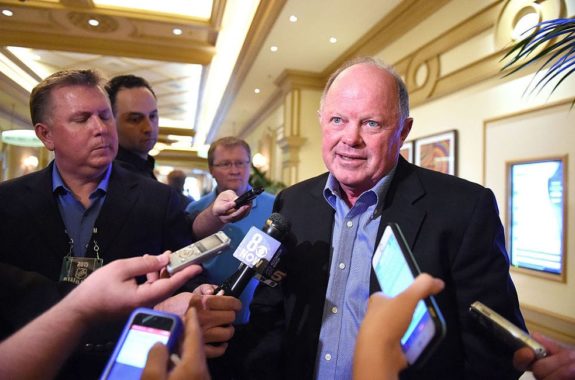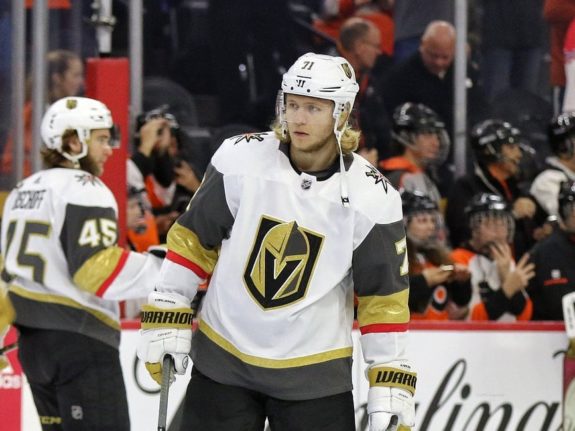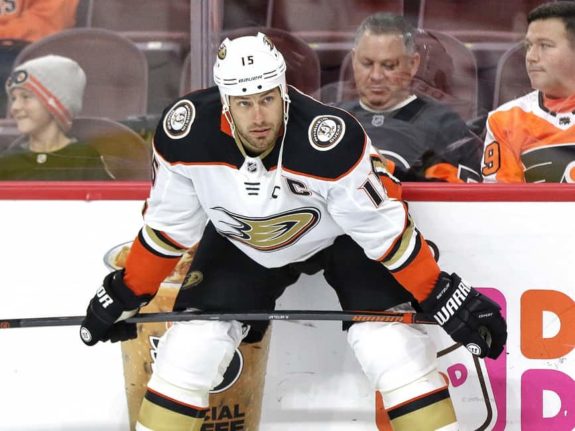Now that we’re all confined to our homes with little to do, our thoughts tend to wander. Without the Anaheim Ducks to watch, some of you may have found yourselves thinking about the one that got away. Just like you with your ex, the Ducks have had their fair share of beauties get away. Here’s a list of the ones they probably want back the most.
From Karlsson to Kunitz: Rules for the Ones That Got Away
Though there are many players the Ducks probably wish they could have had a “redo” with, not all of them qualify for this. This exercise focuses specifically on players who briefly played for the Ducks compared to the other teams with which they excelled. They may have had success during their stay in Anaheim, but they had far more elsewhere. They also had to be relatively young when they left town.
Related: Remembering the Anaheim Mighty Ducks’ 2003 Draft
Additionally, this isn’t an article meant to harp on bad trades nor is it about players who were traded, excelled elsewhere but wouldn’t have helped the Ducks anyway. For example, Freddie Andersen appears to have been well worth the first- and second-rounder the Toronto Maple Leafs traded to Anaheim for his services. but that doesn’t mean the Ducks would’ve fared any better over the past few seasons if they had kept him.

Andersen was expendable because the Ducks had John Gibson, and although the team hasn’t had success, their weakness hasn’t been in goal. With that out of the way, let’s get to the “what ifs.”
William Karlsson Blindsides the NHL
William Karlsson might be the actual “one that got away” and it wasn’t just the Ducks that passed on him either. The Columbus Blue Jackets also saw fit to let him leave via the 2017 expansion draft.
Both teams are likely regretting their decision.
For the Ducks and Karlsson, the missed connection was all about timing. Anaheim drafted the Swedish center No. 53 overall in 2011. By 2014, it looked like Karlsson was ready to make a run at the Ducks roster.
Unfortunately, the Ducks also drafted fellow Swede Rickard Rakell 23 slots before him in their fruitful 2011 Draft. Though he plays primarily on the wing now, Rakell started his Ducks career at center at the same time as Karlsson. That left the two competing for time in a crowded Ducks offensive corps, especially at the center position. There was only enough consistent playing time for one of them, and Rakell took the job. He finished the 2014-15 season with nine goals and 22 assists in 71 games. Meanwhile, Karlsson appeared in only 18 games scoring two goals and adding an assist.
Buyer Beware
At the trade deadline of 2015, the Ducks were in the middle of their most recent window of contention for the Stanley Cup. They were coming off a Western Conference Semifinal, seven-game loss to their hated rival, the Los Angeles Kings, who were on their way to a second Stanley Cup title in three seasons. The Ducks were itching to “keep up with the Jones’” in more ways than one.

They were primed to spend at the deadline, and Karlsson seemed expendable so Anaheim could solidify their defense. It culminated in a March 2, 2015 trade that sent Karlsson to the Blue Jackets along with Rene Bourque and a second-round pick for James Wisniewski and a 2015 third-rounder. That trade would become one of the most unfortunate in recent memory, although it’s hard to fault Bob Murray for doing it knowing what he knew at the time.
The rest is painful history for both Ducks and Blue Jackets fans.
After the trade, Karlsson spent two full seasons with the Blue Jackets in a bottom-six role. In 2017, Columbus exposed him in the expansion draft and made a trade to ensure the Vegas Golden Knights would draft him.
Karlsson and the Golden Knights were a match made in heaven as he scored a whopping 43 goals and added 35 assists for Vegas during their improbable run to the Stanley Cup Final.
Though Karlsson hasn’t sustained that type of production, he has carved out an effective, top-six role with the Golden Knights. He eclipsed 50 points in 2018-19 and was on his way to doing so again in 2019-20 before the NHL suspended its season due to the coronavirus pandemic.
What If?
Ducks fans are left asking themselves, what if? Though it’s hard to fault Murray for trading Karlsson when he did, recent history hurts a little. Rakell out-produced Karlsson significantly in the first two seasons after the Ducks traded “Wild Bill,” but the tables have since turned. Karlsson has outproduced Rakell by an average of almost nine points over the past three seasons.
Related: Anaheim Ducks Logo History
On top of his playmaking skills and two-way game, Karlsson possesses tools that the Ducks have sorely lacked during their two-season plunge to the bottom of the NHL standings, speed and finishing ability.

What if Karlsson remained with the Ducks and centered the “Swede line” between Jakob Silfverberg and Rakell? Head coach Dallas Eakins has preferred to spread out his talent playing them on two different lines, but when they’ve played together, they’ve had some magic moments.
Imagine Karlsson bringing his creativity, speed and skill to that line? The Ducks may have been a playoff bubble team for the past two seasons rather than competing for the first-overall pick.
Chris Kunitz Shows He’s the Best Wingman
The Mighty Ducks (as they were known at the time) signed Chris Kunitz as a free agent out of Ferris State University in 2003. He spent the majority of 2003-04 playing for the Ducks’ AHL affiliate the Cincinnati Mighty Ducks, where he was fourth on the team in points with 44 and led them in goals with 19. But Kunitz couldn’t translate that production to the NHL during his 21 games with Anaheim tallying only six assists.
He spent the 2005 NHL lockout playing for Cincinnati again, and the following season the Ducks placed him on waivers. Kunitz landed in Atlanta with the Thrashers before they waived him as well, and he returned to the Ducks.
In his second stint with the Ducks, Kunitz found his game. He scored 19 goals and 22 assists in 2005-06 and was a key contributor during the regular season of the Ducks’ 2007 Stanley Cup-winning campaign. He notched a goal and five assists in their Stanley Cup run.
The Trade
That wasn’t it for Kunitz and the Ducks. He spent almost two more productive seasons in Anaheim before newly minted Ducks general manager Murray included him in what was his first major trade.
On Feb. 26, 2009, Murray traded Kunitz and Eric Tangradi to the Pittsburgh Penguins for puck-moving defenseman Ryan Whitney.
The trade is infamous over a decade later thanks to Whitney’s popularity as one of the hosts of the podcast “Spittin Chiclets,” where he frequently agonizes over the missed opportunity to win a Stanley Cup with the Penguins, who went on to win it that season.
Agonizing doesn’t quite describe how Ducks fans should feel about it, but painful would suffice. If Kunitz hadn’t won a Cup with the Penguins that season and two more after that, he probably wouldn’t be included in this article, but he did and he is, for good reason.
The King of Chemistry
Kunitz’s ability to develop chemistry with the best players in the game made him a valuable asset. As Tribune-Review Penguins beat writer Jonathan Bombulie pointed out after Kunitz’s retirement, no player had better chemistry with star Sidney Crosby:
“No winger has scored more goals assisted by Crosby. No winger has assisted on more Crosby goals.
First, when Kunitz came to the Penguins in a 2009 trade, he already had experience playing with high-level talent. His Anaheim teammates included Teemu Selanne, Corey Perry and Ryan Getzlaf.
’I always found they enjoyed playing with me because I would go in on the forecheck, disturb it and get pucks back and go to the net,” Kunitz said. “There wasn’t a lot of change in the way I played.’
Consistency is an attribute Crosby values in a linemate, but so is speed. Kunitz always had the skating ability to keep up with his all-star centerman,”
(from ‘Who has been Sidney Crosby’s top Penguins linemate? Chris Kunitz by a landslide.’ ‘The Tribune-Review, 7/31/2019) .
Kunitz’s ability to play with Crosby was part of the formula that helped put the Penguins over the top, and he molded that game in Anaheim.
What If?
What if Kunitz had remained in Anaheim for his career instead of Pittsburgh? Could the Ducks have won another Cup?
Considering how long the Ducks had the services of Perry, Getzlaf and Selanne, they might have. Kunitz was known for his ability to play with those elite players, and the Ducks would’ve had all three of them for five more seasons; Perry and Getzlaf were together for another decade.

Would things have grown complicated? Absolutely. All four players made a significant amount of money, and the arrival of Bobby Ryan is part of what made Kunitz expendable. It wasn’t realistic for the Ducks to keep Kunitz, but if they had a crystal ball, they might have.
A Shea Theodore-Sized Hole on the Blue Line
Shea Theodore is the most recent example of a player who got away from and probably the most impactful as things stand. When the Ducks drafted him No. 26 overall in 2013, they were cultivating a strong group of offensive defensemen.
They already had Cam Fowler, Hampus Lindholm and Sami Vatanen and they drafted Brandon Montour the year after Theodore. They also hit on sixth-rounder Josh Manson, who they drafted out of Northeastern University in 2011.
That made for a strong stable of defensemen and a sunny outlook for the team’s future on the blue line. Things have changed drastically since, and much of that is due to the loss of Theodore.
Theodore spent most of his first two seasons with the franchise playing for his WHL team, the Seattle Thunderbirds. He made his NHL debut in 2015-16 and played 53 NHL games over two seasons totaling 17 points.
However, Theodore did have an impact on the Ducks during his brief tenure with the team and it came in their final regular-season game against the Kings.
Anaheim needed a win to seal the Pacific Division title, and the game was tied at three in overtime when Theodore took a chip pass from Rakell and went top corner on Jonathan Quick for the victory.
When the expansion draft came along in 2017, Theodore was still a young, promising prospect who hadn’t asserted his presence in the NHL. The Ducks and Murray were more concerned with keeping Manson and Vatanen. Murray decided to go with proven commodities rather than take a risk on Theodore and traded him to the newly formed Golden Knights in exchange for not drafting Manson or Vatanen.
All Theodore did after the trade was put up 112 points in 211 regular-season games while averaging nearly 21 minutes of ice time and becoming a fixture on the Vegas power play.
The Missing Defenseman
Almost three seasons later, Montour and Vatanen are gone, and Manson’s offensive production has waned. Fowler had an excellent 2019-20 season before his injury, while Lindholm took a step back in his production as well.
With the benefit of hindsight, having Theodore would be a significant help to a Ducks team desperately in need of offense from their blue line. They now have to pin their hopes on Josh Mahura or Jacob Larsson coming into their own or that one of their recent draft picks will come to the rescue.
All of these players would have significantly benefited the Ducks had they been able to retain their services. Unfortunately, the circumstances were such that the Ducks could not hold onto them. Hindsight makes the loss painful but for Murray, there was no way to know that unproven commodities like Theodore and Karlsson would blossom into such productive players. Keeping Kunitz might have been an easier decision if not for the emergence of Ryan. It’s hard to fault Murray for making the moves that he did in these situations, but it’s still painful to imagine what might have been.
All stats from hockey-reference.com and nhltradetracker.com